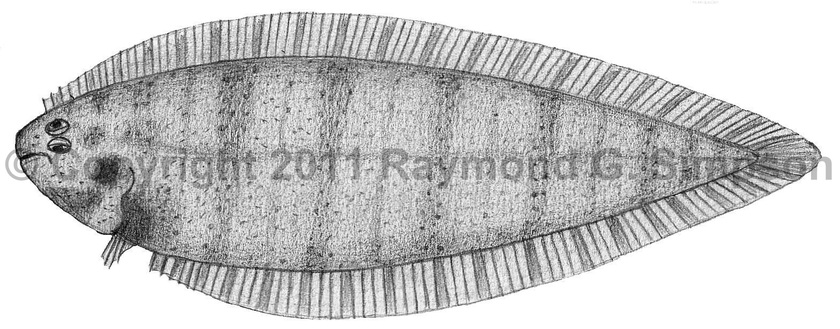
Common Name
Blackcheek Tonguefish
Year Described
Linnaeus, 1766
Identification
Dorsal Fin Rays: 81-91
Anal Fin Rays: 66-75
Pectoral Fin Rays: none
Pelvic Fin Rays: 4
Caudal Fin Rays: 10
Longitudinal Scale Rows: 76-86
Vertebrae: 44-49
Pterygiophore pattern (1st three interneural spaces): 1-4-3
Other diagnostic characters include: pupillary operculum absent, ocular side premaxilla usually toothless, ocular side lower jaw with fleshy ridge, blind side of dorsal and anal fins with a single row of well devloped scales that extend up 3/4 of rays, and scales on ocular side of dorsal and anal fin.
Color
Variable shades of tan to brown with variable darker markings including irregular crossbands, mottling, or blotches. Coloration is dependent on substrate. There is a conspicuous dark blotch on the opercle, especially in large specimens. The inner lining of the opercle is also darkly pigmented. Peritoneum unpigmented. Dorsal, anal, and caudal fins dusky brown with faint markings. Blind side cream with no melanophores.
Size
Adults common from 120-160mm. Maximum size to 210mm.
Habitat
A shallow water species caught from 1-183m (usually <30m), over soft bottoms. Juveniles occur in shallow marshes and estuaries, with adults living in deeper waters with maturity. Mature adults spawn inshore and move offshore afterward. Tolerates low salinity, especially juveniles.
Range Map

Range
From New York to S. Florida, the Gulf of Mexico, Cuba, and the Bahamas. Not found in the rest of the Caribbean or S. America.
References
Munroe, T.A. 1998. Systematics and ecology of western Atlantic tonguefishes (Symphurus: Cynoglossidae: Pleuronectiformes). Fish. Bull. 96(1):1-182.
Munroe, T. A. 2003. Bothidae (Pp. 1885-1895), Scophthalmidae (Pp. 1896-1897), Paralichthyidae (Pp. 1898-1921), Poecilopsettidae (Pp. 1922-1923), Achiridae (Pp. 1925-1933), Cynoglossidae (Pp. 1934-1959). In: Carpenter. 2003. The living marine resources of the Western Central Atlantic v. 3.